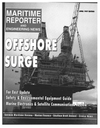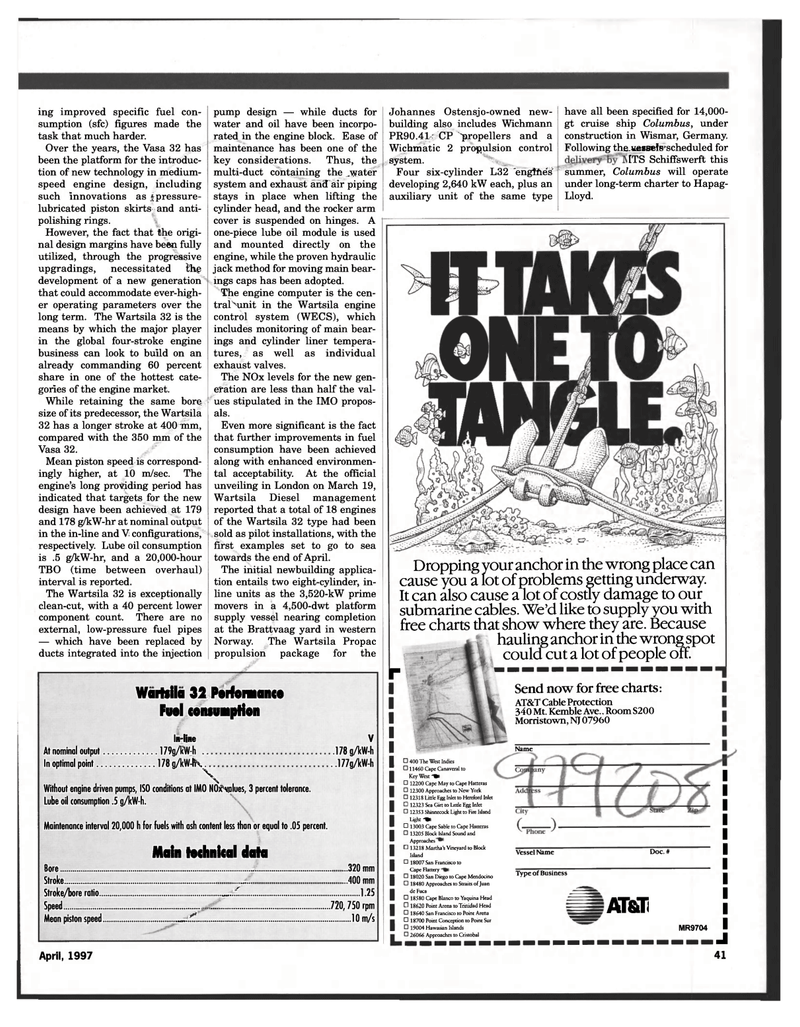
Page 41: of Maritime Reporter Magazine (April 1997)
Read this page in Pdf, Flash or Html5 edition of April 1997 Maritime Reporter Magazine
ing improved specific fuel con- sumption (sfc) figures made the task that much harder.
Over the years, the Vasa 32 has been the platform for the introduc- tion of new technology in medium- speed engine design, including such innovations as pressure- lubricated piston skirts and anti- polishing rings.
However, the fact that the origi- nal design margins have been fully utilized, through the progressive upgradings, necessitated thg development of a new generation that could accommodate ever-high- er operating parameters over the long term. The Wartsila 32 is the means by which the major player in the global four-stroke engine business can look to build on an already commanding 60 percent share in one of the hottest cate- gories of the engine market.
While retaining the same bore size of its predecessor, the Wartsila 32 has a longer stroke at 400 "mm, compared with the 350 mm of the
Vasa 32.
Mean piston speed is correspond- ingly higher, at 10 m/sec. The engine's long providing period has indicated that targets for the new design have been achieved at 179 and 178 g/kW-hr at nominal output in the in-line and V configurations, respectively. Lube oil consumption is .5 g/kW-hr, and a 20,000-hour
TBO (time between overhaul) interval is reported.
The Wartsila 32 is exceptionally clean-cut, with a 40 percent lower component count. There are no external, low-pressure fuel pipes — which have been replaced by ducts integrated into the injection pump design — while ducts for water and oil have been incorpo- rated in the engine block. Ease of maintenance has been one of the key considerations. Thus, the multi-duct containing the water system and exhaust and air piping stays in place when lifting the cylinder head, and the rocker arm cover is suspended on hinges. A one-piece lube oil module is used and mounted directly on the engine, while the proven hydraulic jack method for moving main bear- ings caps has been adopted.
The engine computer is the cen- tral unit in the Wartsila engine control system (WECS), which includes monitoring of main bear- ings and cylinder liner tempera- tures, as well as individual exhaust valves.
The NOx levels for the new gen- eration are less than half the val- ues stipulated in the IMO propos- als.
Even more significant is the fact that further improvements in fuel consumption have been achieved along with enhanced environmen- tal acceptability. At the official unveiling in London on March 19,
Wartsila Diesel management reported that a total of 18 engines of the Wartsila 32 type had been sold as pilot installations, with the first examples set to go to sea towards the end of April.
The initial newbuilding applica- tion entails two eight-cylinder, in- line units as the 3,520-kW prime movers in a 4,500-dwt platform supply vessel nearing completion at the Brattvaag yard in western
Norway. The Wartsila Propac propulsion package for the
Wartsila 32 Performance
Fuel consumption
In-line g/kW-l
In optimal point 178 g/kW-l
At nominal output 179g/kW-h .. g/kW-h .. \
V .178 gAW-h , ,177g/kW-h % Without engine driven pumps, ISO conditions at IMO NO)Pv.alues, 3 percent tolerance, tube oil consumption .5 g/kW-h.
Maintenance interval 20,000 h for fuels with ash content less than or equal to .05 percent.
Main technical data
Bore
Stroke ........ tT ..320 mm ..400 mm
Stroke/bore ratio 1.25
Speed 720,750 rpm
Mean piston speed £ 10 m/s
Johannes Ostensjo-owned new- building also includes Wichmann
PR90.41 CP "propellers and a
Wichmatic 2 propulsion control system.
Four six-cylinder L32 engftie's1 developing 2,640 kW each, plus an auxiliary unit of the same type have all been specified for 14,000- gt cruise ship Columbus, under construction in Wismar, Germany.
Following the.vessels scheduled for
ITS Schiffswerft this summer, Columbus will operate under long-term charter to Hapag-
Lloyd.
Dropping your anchor in the wrong place can cause you a lot of problems getting underway.
It can also cause a lot of costly damage to our submarine cables. We'd like to supply you with free charts that show where they are. Because hauling anchor in the wrong spot could cut a lot of people off. r
Send now for free charts:
AT&T Cable Protection 340 Mt. Kemble Ave Room S200
Morristown, NJ 07960
Name • 400 The West Indies
O 11460 Cape Canaveral to
Key West -»i • 12200 Cape May to Cape Hatteras • 12300 Approaches to New York • 12318 Little Egg Inlet to Hereford Inlet • 12323 Sea Girt to Little Egg Inlet • 12353 Shinnecock Light to Fire Island
Light -») • 13003 Cape Sable to Cape Hatteras • 13205 Block Island Sound and
Approaches • 13218 Martha's Vineyard to Block
Island • 18007 San Francisco to
Cape Flattery • 18020 San Diego to Cape Mendocino • 18480 Approaches to Straits of Juan de Fuca • 18580 Cape Blanco to Yaquina Head • 18620 Point Arena to Trinidad Head • 18640 San Francisco to Point Arena • 18700 Point Conception to Point Sur • 19004 Hawaiian Islands • 26066 Approaches to Cristobal
Vessel Name Doc. #
Type of Business
AT&T
MR9704
April, 1997 43
I
I
I
I
I
I
I
I
I
I
I
J 41

 40
40

 42
42
